Abstract
This study illustrates possible influences of consumption of ethanol on the pharmacokinetic behaviour of inhaled trichloroethylene (TRI) in relation to biological monitoring of exposure. The results were obtained for a standard male worker of 70 kg by physiologically based pharmacokinetic modelling. Depending on the pattern of consumption of ethanol, enzyme inhibition or induction was assumed to prevail in this worker. The inhibition and induction were modelled by assuming competitive metabolic interaction between TRI and ethanol and increased maximum velocity (Vmax) of TRI metabolism respectively. Ingestion of moderate amounts of ethanol before the start of work or at lunch time, but not at the end of work, caused pronounced increases in blood TRI concentrations and decreases in the urinary excretion rates of TRI metabolites, this effect lasting until the next day. The effects were smaller the higher the exposure concentration of TRI. Induction of TRI metabolism, supposedly by consumption of ethanol the previous evening, caused only small changes in the pharmacokinetic profile at 50 ppm, but appreciable changes at 500 ppm.
Full text
PDF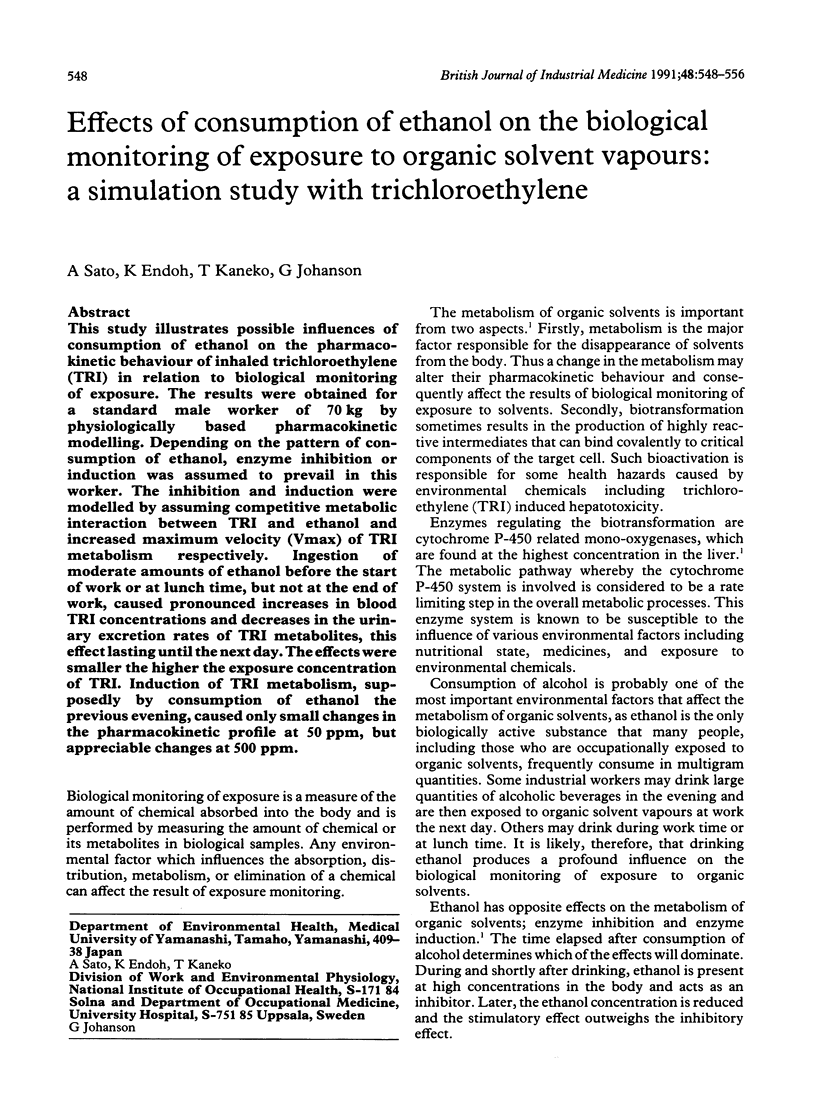
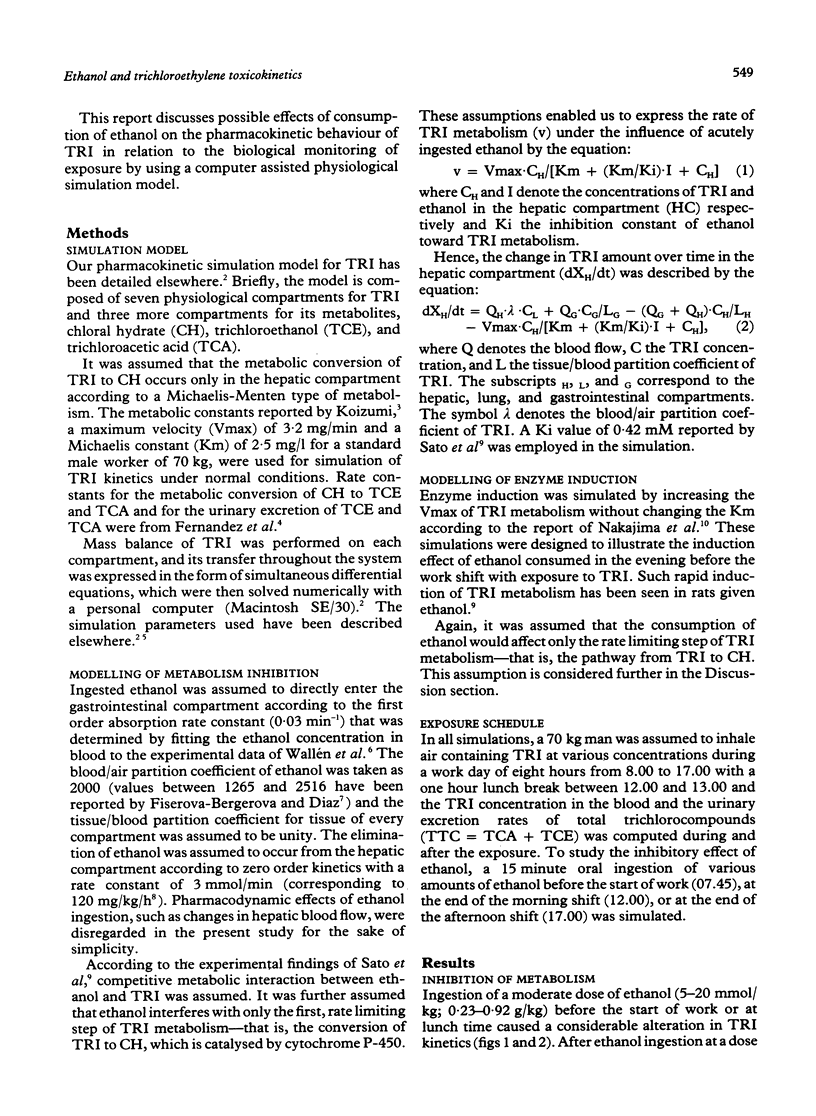
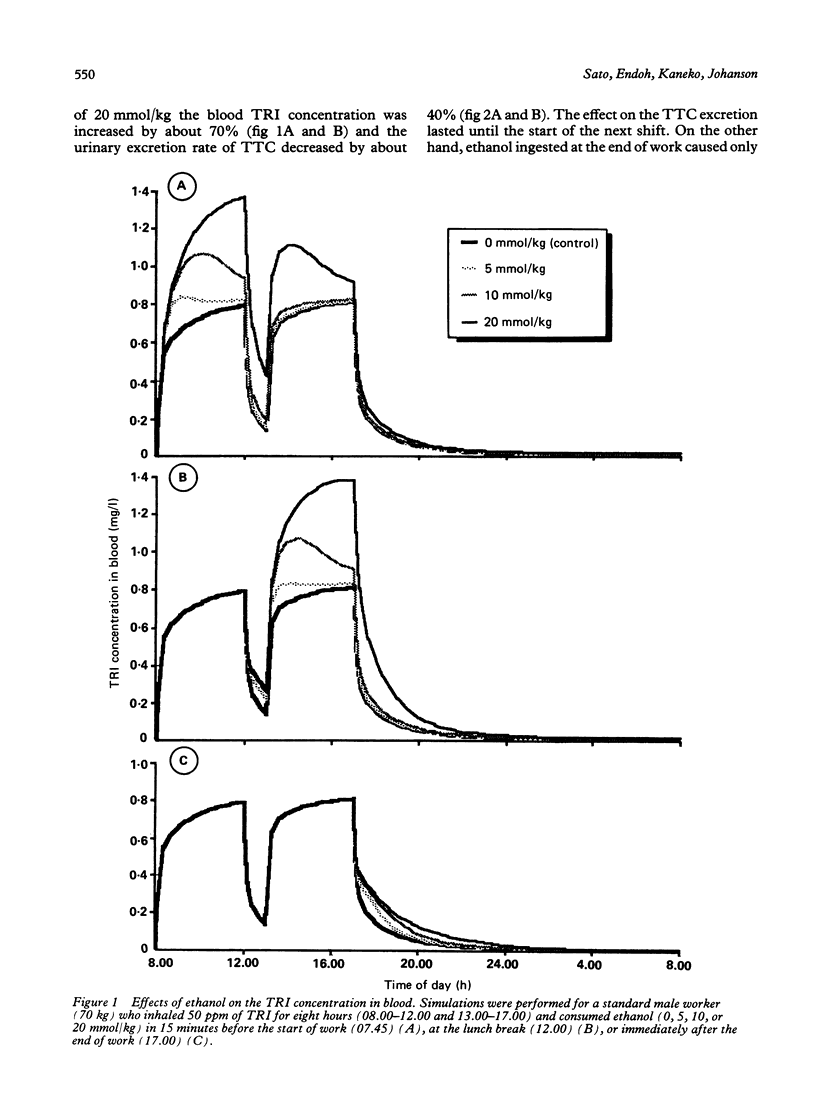

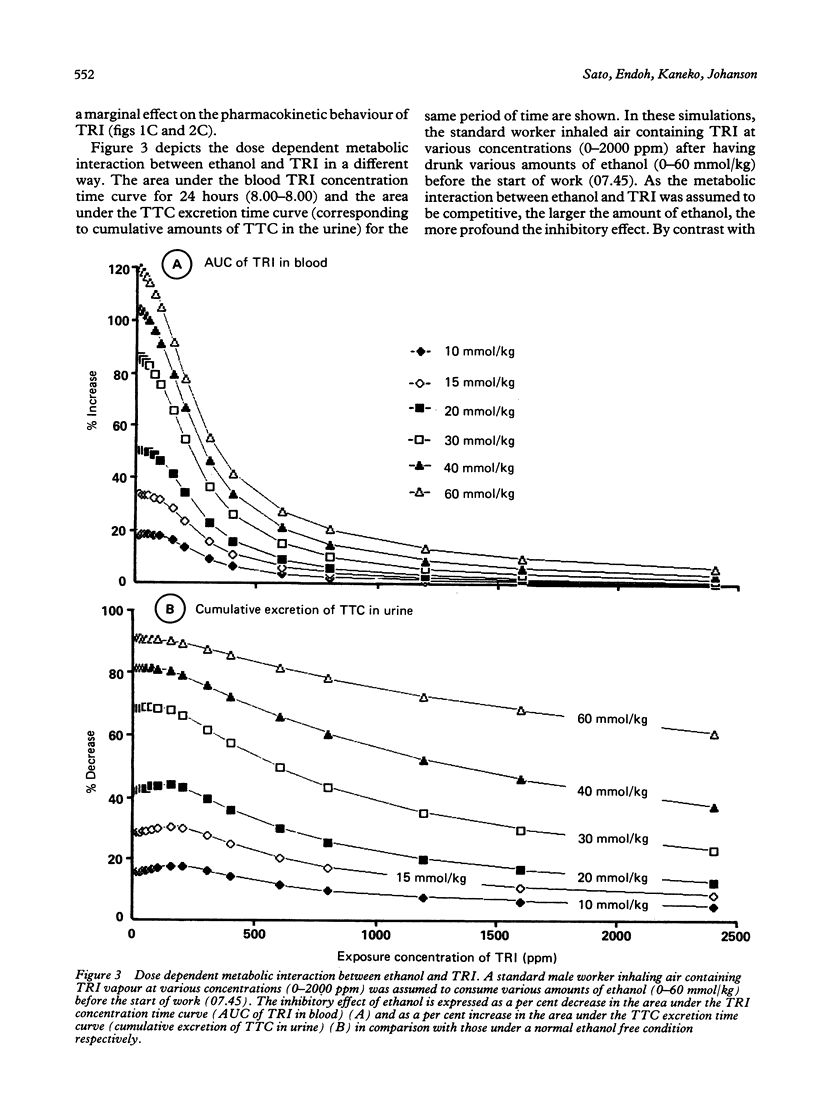
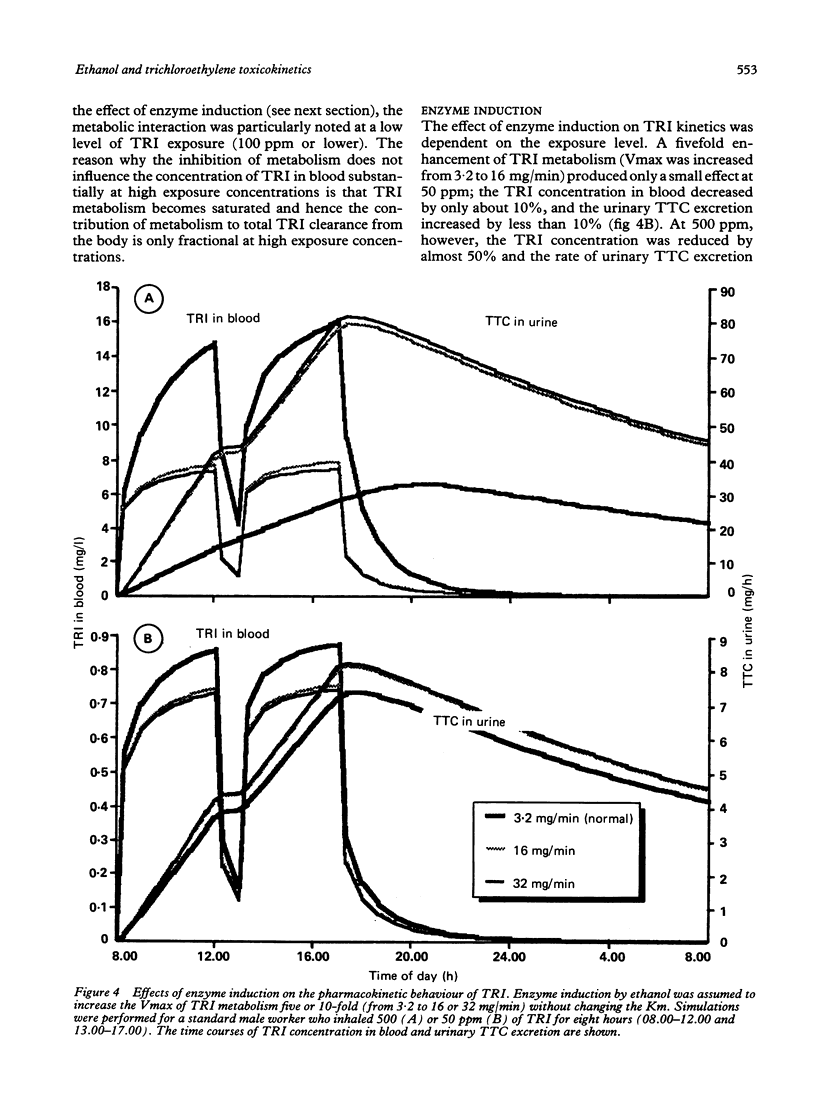
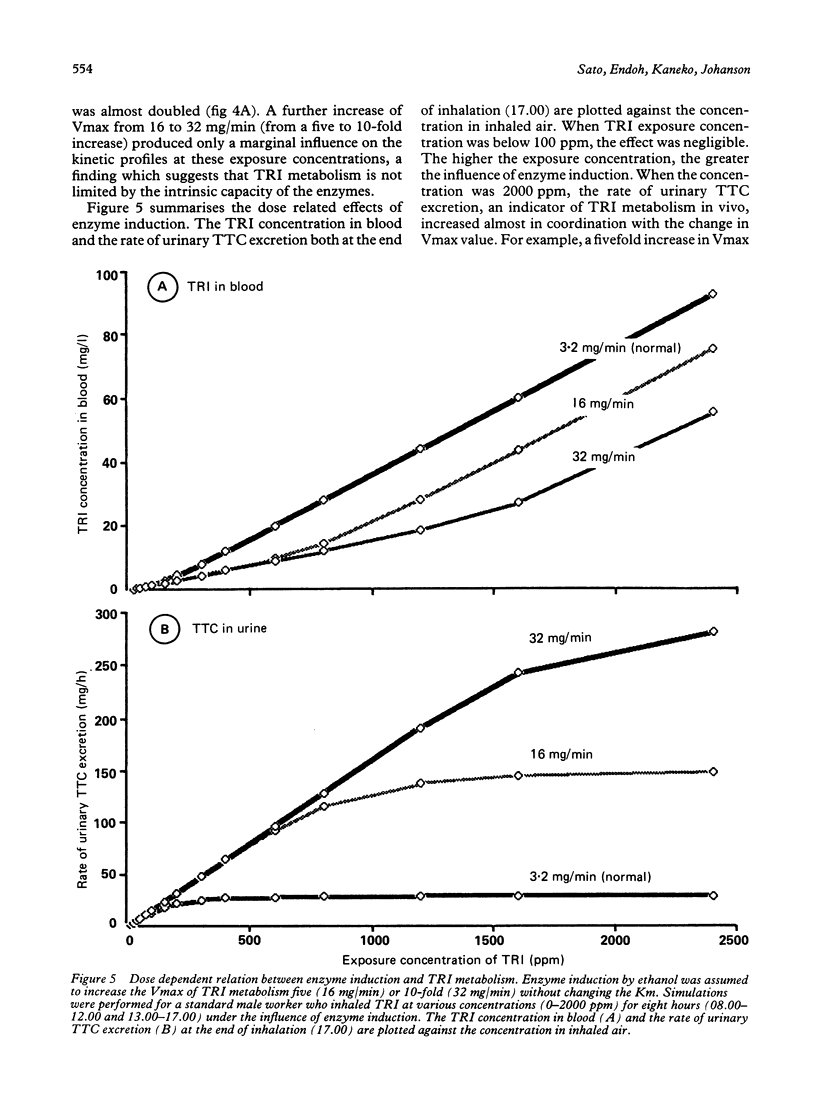
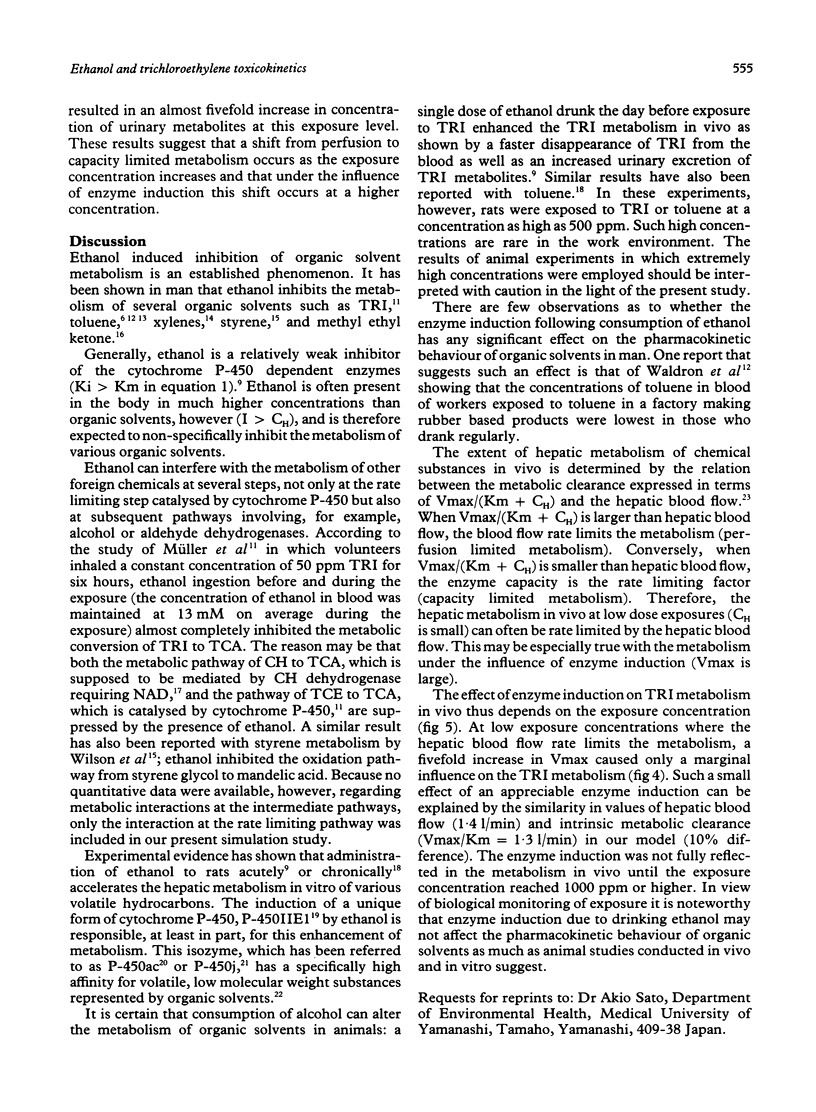
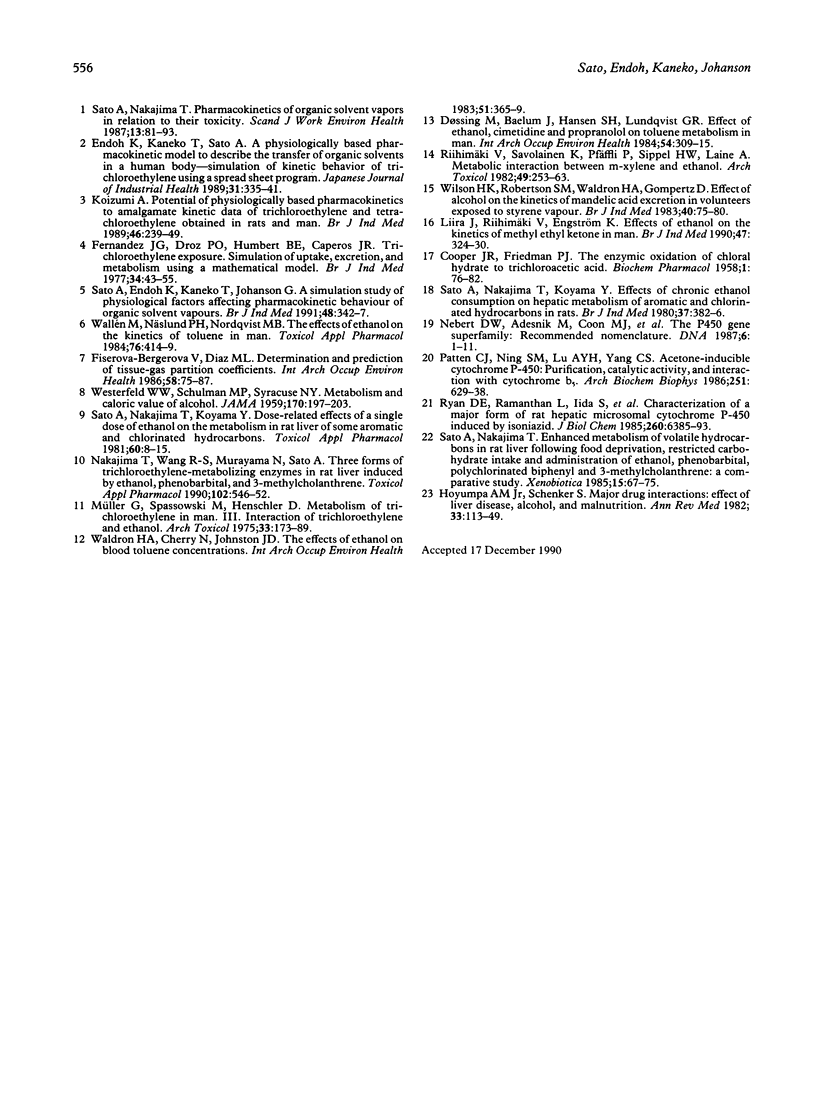
Selected References
These references are in PubMed. This may not be the complete list of references from this article.
- Døssing M., Baelum J., Hansen S. H., Lundqvist G. R. Effect of ethanol, cimetidine and propranolol on toluene metabolism in man. Int Arch Occup Environ Health. 1984;54(4):309–315. doi: 10.1007/BF00378584. [DOI] [PubMed] [Google Scholar]
- Endoh K., Kaneko T., Sato A. [A physiologically based pharmacokinetic model to describe the transfer of organic solvents in the human body. Simulation of kinetic behavior of trichloroethylene using a spreadsheet program]. Sangyo Igaku. 1989 Sep;31(5):335–341. doi: 10.1539/joh1959.31.335. [DOI] [PubMed] [Google Scholar]
- Fernández J. G., Droz P. O., Humbert B. E., Caperos J. R. Trichloroethylene exposure. Simulation of uptake, excretion, and metabolism using a mathematical model. Br J Ind Med. 1977 Feb;34(1):43–55. doi: 10.1136/oem.34.1.43. [DOI] [PMC free article] [PubMed] [Google Scholar]
- Fiserova-Bergerova V., Diaz M. L. Determination and prediction of tissue-gas partition coefficients. Int Arch Occup Environ Health. 1986;58(1):75–87. doi: 10.1007/BF00378543. [DOI] [PubMed] [Google Scholar]
- Hoyumpa A. M., Jr, Schenker S. Major drug interactions: effect of liver disease, alcohol, and malnutrition. Annu Rev Med. 1982;33:113–149. doi: 10.1146/annurev.me.33.020182.000553. [DOI] [PubMed] [Google Scholar]
- Koizumi A. Potential of physiologically based pharmacokinetics to amalgamate kinetic data of trichloroethylene and tetrachloroethylene obtained in rats and man. Br J Ind Med. 1989 Apr;46(4):239–249. doi: 10.1136/oem.46.4.239. [DOI] [PMC free article] [PubMed] [Google Scholar]
- Müller G., Spassowski M., Henschler D. Metabolism of trichloroethylene in man. III. Interaction of trichloroethylene and ethanol. Arch Toxicol. 1975;33(3):173–189. doi: 10.1007/BF00311271. [DOI] [PubMed] [Google Scholar]
- Nakajima T., Wang R. S., Murayama N., Sato A. Three forms of trichloroethylene-metabolizing enzymes in rat liver induced by ethanol, phenobarbital, and 3-methylcholanthrene. Toxicol Appl Pharmacol. 1990 Mar 1;102(3):546–552. doi: 10.1016/0041-008x(90)90049-z. [DOI] [PubMed] [Google Scholar]
- Nebert D. W., Adesnik M., Coon M. J., Estabrook R. W., Gonzalez F. J., Guengerich F. P., Gunsalus I. C., Johnson E. F., Kemper B., Levin W. The P450 gene superfamily: recommended nomenclature. DNA. 1987 Feb;6(1):1–11. doi: 10.1089/dna.1987.6.1. [DOI] [PubMed] [Google Scholar]
- Patten C. J., Ning S. M., Lu A. Y., Yang C. S. Acetone-inducible cytochrome P-450: purification, catalytic activity, and interaction with cytochrome b5. Arch Biochem Biophys. 1986 Dec;251(2):629–638. doi: 10.1016/0003-9861(86)90373-5. [DOI] [PubMed] [Google Scholar]
- Riihimäki V., Savolainen K., Pfäffli P., Pekari K., Sippel H. W., Laine A. Metabolic interaction between m-xylene and ethanol. Arch Toxicol. 1982 Mar;49(3-4):253–263. doi: 10.1007/BF00347873. [DOI] [PubMed] [Google Scholar]
- Ryan D. E., Ramanathan L., Iida S., Thomas P. E., Haniu M., Shively J. E., Lieber C. S., Levin W. Characterization of a major form of rat hepatic microsomal cytochrome P-450 induced by isoniazid. J Biol Chem. 1985 May 25;260(10):6385–6393. [PubMed] [Google Scholar]
- Sato A., Endoh K., Kaneko T., Johanson G. A simulation study of physiological factors affecting pharmacokinetic behaviour of organic solvent vapours. Br J Ind Med. 1991 May;48(5):342–347. doi: 10.1136/oem.48.5.342. [DOI] [PMC free article] [PubMed] [Google Scholar]
- Sato A., Nakajima T. Enhanced metabolism of volatile hydrocarbons in rat liver following food deprivation, restricted carbohydrate intake, and administration of ethanol, phenobarbital, polychlorinated biphenyl and 3-methylcholanthrene: a comparative study. Xenobiotica. 1985 Jan;15(1):67–75. doi: 10.3109/00498258509045336. [DOI] [PubMed] [Google Scholar]
- Sato A., Nakajima T., Koyama Y. Dose-related effects of a single dose of ethanol on the metabolism in rat liver of some aromatic and chlorinated hydrocarbons. Toxicol Appl Pharmacol. 1981 Aug;60(1):8–15. doi: 10.1016/0041-008x(81)90129-0. [DOI] [PubMed] [Google Scholar]
- Sato A., Nakajima T., Koyama Y. Effects of chronic ethanol consumption on hepatic metabolism of aromatic and chlorinated hydrocarbons in rats. Br J Ind Med. 1980 Nov;37(4):382–386. doi: 10.1136/oem.37.4.382. [DOI] [PMC free article] [PubMed] [Google Scholar]
- Sato A., Nakajima T. Pharmacokinetics of organic solvent vapors in relation to their toxicity. Scand J Work Environ Health. 1987 Apr;13(2):81–93. doi: 10.5271/sjweh.2075. [DOI] [PubMed] [Google Scholar]
- WESTERFELD W. W., SCHULMAN M. P. Metabolism and caloric value of alcohol. J Am Med Assoc. 1959 May 9;170(2):197–203. doi: 10.1001/jama.1959.63010020007016. [DOI] [PubMed] [Google Scholar]
- Waldron H. A., Cherry N., Johnston J. D. The effects of ethanol on blood toluene concentrations. Int Arch Occup Environ Health. 1983;51(4):365–369. doi: 10.1007/BF00378350. [DOI] [PubMed] [Google Scholar]
- Wallén M., Näslund P. H., Nordqvist M. B. The effects of ethanol on the kinetics of toluene in man. Toxicol Appl Pharmacol. 1984 Dec;76(3):414–419. doi: 10.1016/0041-008x(84)90345-4. [DOI] [PubMed] [Google Scholar]
- Wilson H. K., Robertson S. M., Waldron H. A., Gompertz D. Effect of alcohol on the kinetics of mandelic acid excretion in volunteers exposed to styrene vapour. Br J Ind Med. 1983 Feb;40(1):75–80. doi: 10.1136/oem.40.1.75. [DOI] [PMC free article] [PubMed] [Google Scholar]


